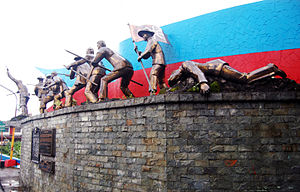
Emilio Aguinaldo y Famy was a Filipino revolutionary, statesman, and military leader who is the youngest president of the Philippines (1899–1901) and became the first president of the Philippines and of an Asian constitutional republic. He led the Philippine forces first against Spain in the Philippine Revolution (1896–1898), then in the Spanish–American War (1898), and finally against the United States during the Philippine–American War (1899–1901).
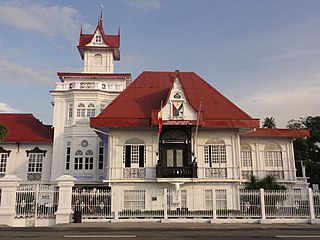
Cavite, officially the Province of Cavite, is a province in the Philippines located in the Calabarzon region in Luzon. Located on the southern shores of Manila Bay and southwest of Manila, it is one of the most industrialized and fastest-growing provinces in the Philippines. As of 2020, it has a population of 4,344,829, making it the most populated province in the country if the independent cities of Cebu are excluded from Cebu's population figure.
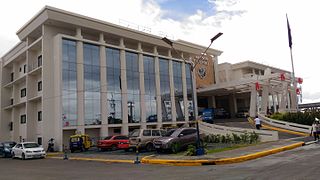
Bacoor, officially the City of Bacoor, is a 1st class component city in the province of Cavite, Philippines. According to the 2020 census, it has a population of 664,625 people, making it the 15th most populous city in the Philippines and the second largest city in the province of Cavite after Dasmariñas.

The Philippine Revolution was a war of independence waged by the revolutionary organization Katipunan against Spain from 1896 to 1898. It was the culmination of the 333-year colonial rule of Spain to the archipelago. The Philippines were among the last colonies of the Spanish Empire, which saw a massive decline particularly in the 1890s. Cuba rebelled in 1895, and the empire soon fought against the United States in a war that they lost. In June 1898, Philippine revolutionaries declared independence. However, this was not recognized by Spain, which sold the islands to the United States in the Treaty of Paris.

Imus, officially the City of Imus, is a 3rd class component city and de jure capital of the province of Cavite, Philippines. According to the 2020 census, it has a population of 496,794 people.

Kawit, officially the Municipality of Kawit, is a 1st class municipality in the province of Cavite, Philippines. According to the 2020 census, it has a population of 107,535. It is one of the notable places that had a major role in the country's history during the 1800s and 1900s.

Baldomero Aguinaldo y Baloy was a leader of the Philippine Revolution. He was the first cousin of Emilio Aguinaldo, the first president of the Philippines, as well as the grandfather of Cesar Virata, a former prime minister in the 1980s.

General Licerio Topacio (1839–1925) was a leader in the Philippine independence movement.

The Magdalo was a faction of the Katipunan chapter in Cavite.
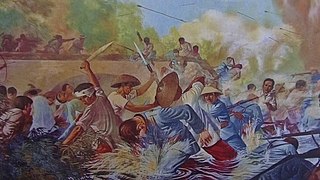
The Battle of Zapote Bridge was fought on February 17, 1897, as part of the Philippine Revolution. Filipino revolutionary forces led by General Emilio Aguinaldo defeated Spanish forces under the command of Governor-General Camilo de Polavieja. In this battle, General Edilberto Evangelista was killed.
José Tagle y Santarin was a Filipino military officer who participated in the Battle of Imus during the Philippine Revolution.
Críspulo Aguinaldo y Famy was a native of Kawit, Cavite the older brother of Emilio Aguinaldo and lieutenant general who heroically defended in the Battle of Pasong Santol.

The Battle of Binakayan–Dalahican was a simultaneous battle during the Philippine Revolution that was fought on November 9–11, 1896 that led to a decisive Filipino victory. The twin battle took place at the shores of Binakayan, in the town of Cavite Viejo ; Dalahican and Dagatan in Noveleta; and, to minimal extent, in Imus and Bacoor towns in Cavite, Philippines that lasted for two days before the Spanish army retreated demoralized and in disarray. The result of the battle was the first significant Filipino victory in the country's history.
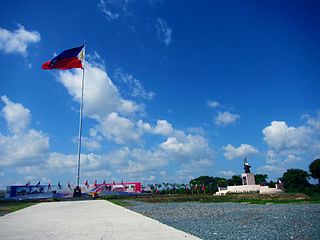
The Battle of Alapan was fought on May 28, 1898, and was the first military victory of the Filipino Revolutionaries led by Emilio Aguinaldo after his return to the Philippines from Hong Kong. After the American naval victory in the Battle of Manila Bay, Aguinaldo returned from exile in Hong Kong, reconstituted the Philippine Revolutionary Army, and fought against the Spanish troops in a garrison in Alapan, Imus, Cavite. The battle lasted for five hours, from 10:00 A.M. to 3:00 P.M.
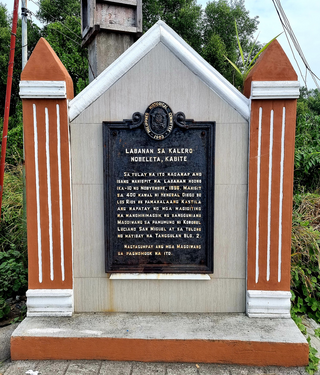
The Battle of Noveleta known as Battle of Calero Bridge was a major battle during the Philippine revolution and was one of the first engagements of the revolution in Cavite. In the latter part of the revolution, Noveleta played a key role for the Magdalo and Magdiwang factions. From its capture by the Magdiwang at the start of the revolution, various battles were fought and won by Filipino rebels in Cavite. Noveleta became the seat of the Magdiwang faction of the Katipunan.
The Kawit revolt was a short skirmish in the beginning of the revolution in Cavite. Gen. Emilio Aguinaldo, The First President of the Philippines, led some 400 men to the town hall of Kawit, guarded by a few Guardia Civil there. A few days after the revolt, Aguinaldo marched to Imus to meet the enemy in one of the great battles of the revolution.
The Battle of Perez Dasmariñas was a battle of the Philippine Revolution. It occurred during the Cavite Offensive of 1897, commanded by Maj. Gen. Jose de Lachambre under Governor-General Camilo de Polavieja, as the Spanish aimed to recapture Cavite from Katipunan rebel control. Both the battle and the offensive was a success for the Spanish, and the retreat to Montalban occurred several weeks after the battle.
The Battle of Pateros refers to a series of skirmishes between Spanish troops and revolutionary forces in the towns of Las Piñas, Taguig and Pateros in Manila. These skirmishes occurred shortly after the execution of José Rizal and are considered the renewal of hostilities in Luzon after a period of ceasefire from the Battle of Binakayan to the Rizal execution.

Mamerto Alejandrino Natividad Jr. was a haciendero and a Filipino military leader who led numerous successful battles during the Philippine Revolution against the Spaniards. He is credited with establishing army headquarters at Biak Na Bato, which today is a national park because of its historical significance. Together with Jose Clemente Zulueta, he wrote the proclamation entitled “To The Brave Sons of the Philippines”, which called for the expulsion of the friars from the Philippines. He was a signatory to the Biak Na Bato convention, but a steadfast dissenter to the Treaty of Biak Na Bato, which asked for peace and reforms. He preferred independence.
This is the timeline of the Philippine Revolution—the uprising that gave birth to Asia's first republic. The roots of the revolution trace back to the Cavite mutiny and subsequent execution of Gomburza in 1872, and ended with the declaration of independence from Spain in 1898.
